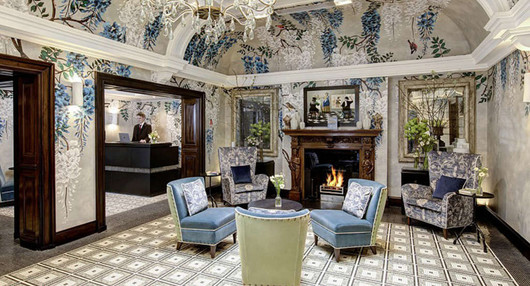Stories Written and Told: the Brown's
- Ankit Malhotra
- Jan 28, 2022
- 7 min read
This note is loosely inspired by the following video.
They say that everyone possesses at least one novel. If you've ever considered finding a space to organise the jumble of words and ideas in your head, you've come to the right place. Brown's is the literati's preferred London hotel. You're in good company here if you're writing a novel: Stephen King reserved a suite in order to complete the opening chapters of his acclaimed novel "Misery." Rudyard Kipling wrote "The Jungle Book" in that same suite, a room overlooking Albemarle Street. In honour of the man who loved to stay there, a framed, handwritten letter is proudly displayed on the wall of what is now the eccentrically decorated Kipling Suite. Though the subject is delightfully banal, involving an allotment in Sussex, it demonstrates that Kipling was so ensconced in the hotel that he conducted business from his room. The great writer was finally struck down by a perforated ulcer in 1936 while sitting at his desk; it would be his final visit, as he died six days later in Middlesex Hospital.
Agatha Christie, the great crime writer, was also a regular. Readers of her novel "At Bertram's Hotel" will undoubtedly notice parallels between what's on the page and what Brown's Hotel is like – the "Queen of Crime" is believed to have modelled her fictitious hotel on this London landmark. A few years ago, the hotel celebrated its association with a "Agatha Christie Afternoon Tea," which included Death on the Nile coffee cake, Evil under the Sun lemon tartlet, and, most importantly, an At Bertram's Hotel cupcake.
A sufficient number of writers to stock a small library
In 1948, AA Milne's son Christopher Robin (he named his character after his own son) married at Brown's. The following year, the hotel hosted a launch party for publishers Weidenfield and Nicholson. George Orwell and Somerset Maugham were among those invited. JRR Tolkien and his family stayed there in 1973. The place is associated with JM Barrie, Arthur Conan Doyle, Oscar Wilde, Robert Louis Stevenson, Bram Stoker, and Samuel Langhorne Clemens, better known as Mark Twain. However, do not believe everything you read: in 1907, the latter described Brown's as "a tranquil, subdued, homelike, old-fashioned English inn... a blessed retreat of a sort now uncommon in England, and becoming scarcer by the year." Yet a year earlier, the Daily Mail had published an exposé on hidden scandals, including one involving a certain WK Vanderbilt's shocking secret marriage at Brown's in 1903. The official line from the hotel's 1906 prospectus painted a more genteel picture, stating that Brown's had "an unmatched reputation as the principal London House for the nobility and those who prefer quiet, style, and elegant comfort."
The connection to Byron
The hotel's original owners also had a literary connection, though they were not writers themselves. James Brown served as Lord Byron's valet, one of the country's greatest poets. Brown and his wife Sarah Willis, who had previously worked as Lady Byron's personal maid, opened what is believed to be London's first hotel with a cash injection from his former employer, who is sadly no longer alive. It was 1837, the year Queen Victoria ascended to the throne. The original hotel was housed in a townhouse at 23 Dover Street, which Brown purchased in order to establish what he dubbed a 'genteel inn.' The hotel expanded over the next two decades, acquiring adjacent properties: number 22 in 1838, number 24 six years later, and number 21 a year later. The structure itself was significantly expanded in the late 1890s, when the owners, by then the Ford family, acquired St George's Hotel. It was adjacent to Brown's and faced Albemarle Street. The two buildings were combined, an additional floor was added, and a new façade for the hotel on Albemarle Street was constructed, providing the hotel with its current address. Three additional townhouses were added in the early 1900s, as if the owners were playing a real-life version of the newly released board game Monopoly. Today, the property consists of eleven adjoining townhouses, which maintains the boutique hotel atmosphere.
The hotel was a roaring success by the time the Browns sold in 1859. However, fortunes in the hotel industry can be fickle, and things could easily have changed in the absence of the Browns' enchantment. As luck would have it, their purchasers were also knowledgeable about running such a business. If anything, its reputation has improved. James Ford and his son James John Ford began their careers in hospitality at a smaller establishment on Manchester Street in Marylebone, a mile north. The Fords were proprietors of a livery stable. As astute businessmen, they recognised an opportunity to increase their profits by offering their customers a place to sleep. Brown's was a step up, but Ford recognised the importance of maintaining the hotel's status. Claridge's opened in 1856, and The Grosvenor made a splash in 1860. Faced with such fierce competition, a comprehensive programme of upgrades and refurbishments was initiated. The owners added electricity, as well as bath tubs – a luxury even for those living in the capital's grandest homes at the time – and elevators.
Behind closed doors – a rich and famous person's favourite
Unsurprisingly, such an opulent and enviably modern hotel attracted – and continues to attract – a wealthy clientele. If you are privy to the contents of the guest ledger in a hotel where discretion is the watchword, it reads like an edition of Who's Who. In the nineteenth century, it became a haven for visiting royalty. Its status was cemented by a steady stream of foreign aristocrats: Charles Brooke, Rajah of Sarawak in 1873, Italian Prince Pignatelli d'Aragon in 1886, German Prince Frederick Augustus of Saxony and French Prince Henri de Bourbon the following year. Queen Victoria paid frequent visits, though with Buckingham Palace just down the road, she never needed to stay the night. As the nineteenth century gave way to the twentieth, little changed. In the mid-1920s, the King of Greece was a frequent visitor, and exiled Ethiopian Emperor Haile Selassie I stayed at Brown's in 1936. Not to mention British royalty. HM The Queen took tea in 1951, when she was still Princess Elizabeth, and Diana, Princess of Wales appeared on occasion four decades later.
Along with royalty, the hotel attracted prominent politicians. In 1865, the 4th Earl of Carnarvon, a prominent Conservative, remained. Howard Carter's 1922 expedition to Egypt, during which the archaeologist discovered Tutankhamen's tomb, was funded by his son. Napoleon III, who was in exile shortly before his death, stayed at the hotel in 1871 with his wife Eugenie. Later, the hotel would host the US Consul General, General E A Merritt, Viceroy of India, and Ismail Pasha, Egypt's Khedive. When Theodore Roosevelt married Edith Kermit Carow, he chose the hotel as his base. She and her sisters had relocated to London in an attempt to save money on living expenses. The wedding licence, which lists Roosevelt's occupation as "ranchman," is on display. However, the newlyweds did not stay at the hotel during their honeymoon, which they spent in Italy. In 1905, his fifth cousin Franklin Roosevelt and his new wife Eleanor Roosevelt made amends by spending their honeymoon at Brown's.
How one actor was denied the star treatment
Naturally, Hollywood A-listers and theatre aficionados have long patronised the establishment. In 1947, BAFTA held its inaugural meeting at Brown's. Laurence Olivier, Michael Powell, Carol Reed, and David Lean were among the guests at the historic event. Orson Welles used it as a base in 1960 while interviewing prospective cast members for a Shakespeare tour. If you were around in the 1970s, you might have noticed Robert Redford holed up in a bar with Mia Farrow. However, the most intriguing storey involving a well-known actor is that of Ralph Fiennes, who was nominated for an Academy Award. Fiennes worked briefly as a hotel porter at Browns while on press junkets for The Grand Budapest Hotel. Fiennes had, of course, been promoted in the Wes Anderson film, playing Monsieur Gustave, the hotel's charismatic concierge who is a stickler for doing things correctly.
It was 1983, and Fiennes had recently completed an art foundation course and was awaiting admission to RADA. Between the two, he worked at London's oldest hotel for six months. Fiennes stated that he saw Jeremy Irons while polishing a glass chandelier. Irons was a household name at the time, owing largely to the success of the 1981 television series Brideshead Revisited. Their encounter could not have been more routine. Irons inquired as to the type of glass cleaner Fiennes was using, and the young aspiring actor responded with a cheeky request for Irons' autograph. Irons agreed to leave it at reception, much to his delight. Fiennes later inquired of the Brown's concierge whether anything had been left for him. It did, and it read as follows:
"Regards, Ralph Continue polishing. Irons, Jeremy."
Monsieur Gustave would have scoffed at such conduct.
The very first telephone call made in London
The hotel's association with the wealthy and famous extends beyond mere guests, as this is widely believed to be the location chosen by Alexander Graham Bell for his first telephone call on British soil. When Bell paid a visit in 1877, the storey goes, he was eager to test his invention before seeking funding. To do so, he required access to a telegraph wire, which numbered less than 2,000 in London at the time. As luck would have it, the Fords had a wire running between their hotel and their home in Ravenscourt Park, about four miles to the west. Though Bell's initial attempt was unsuccessful due to interference from neighbouring wires, he attempted again in the early hours of the morning to make the capital's first telephone call. Although there is no hard evidence that this occurred, the hotel celebrates this historic event as their own. To be fair, there is no evidence that it occurred elsewhere, so why not?
Charles Lindbergh and his wife stayed here shortly before the outbreak of World War II. The reality of such foreboding times was difficult to ignore; she allegedly watched as gas masks were distributed from her hotel window. However, following 1945, things quickly returned to normal.
What would you be willing to pay for a cocktail?
The hotel's home away from home ethos won Churchill over as a wartime leader, but it was the Donovan Bar that he adored. He'd sip on one of his signature martinis. Recently, the bar was reopened under the leadership of the legendary Salvatore Calabrese. Known as the Maestro, the man is the drinks industry's genius. With over forty years of experience, what he doesn't know about cocktail mixing is unimportant. Take a seat at the Donovan Bar and, if you have a large enough wallet, you can splash the cash on some of the world's most expensive vintage cocktails. Consider the Vesper, a cocktail made with a measure of the scarce 1949 Kina Lilet, 1950 Gordon's Gin, and 1950 Smirnoff Vodka. If the name sounds familiar, it is because it was featured in Ian Fleming's Bond novels.
Perhaps the most famous figure associated with Brown's is that of Winston Churchill, the great British leader. He stated the following about the hotel:
"When I visit London, I avoid staying in hotels. I make my home at Brown's."
Now that I have mentioned Sir Winston Churchill, he will have the last word. As he does. Always.
Photographs from the intraweb of Brown's in all its glory.

























Comments